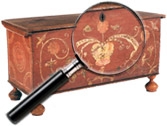|
|
Tagua Nuts
Tagua nuts are the endosperm of a genus of South American palm trees that are found from Panama down through Bolivia and Peru. Tagua nuts, or more accurately, the kernels of tagua seeds, are left behind by the wildlife that feed on the palm’s fruit. The group of palms is often referred to as “tagua palms” or “ivory-nut palms,” because tagua nuts are so hard, they resemble elephant ivory. (In fact, the [...] Click here to continue reading.
Sitting Bull, Sioux Chief (circa 1831 to 1890)
Sitting Bull, the man who would later become the Hunkpapa Sioux chief, was born in South Dakota, near the Grand River. His Lakota name was Tatanka-Iyotanka. In his thirties, he began to build his reputation as a warrior, leading war parties in Red Cloud’s War against a number of Dakota Territory forts. Although the U.S. negotiated with the Sioux in order to end the war and [...] Click here to continue reading.
The Battleship Maine
Construction of the U.S.S. Maine was authorized in August of 1886, and she was launched in 1889 and commissioned in 1895. After several years spent patrolling the East Coast and Caribbean, orders sent the Maine and her crew to Cuba in response to continued civil unrest on the island.
The photograph above is a 1896 image of the ship framed in a sheet iron frame made from remnants of [...] Click here to continue reading.
Hires Root Beer
While traveling in 1875, Charles E. Hires, a Philadelphia pharmacist, first tasted root beer. Root beer, traditionally made with sassafras, was a popular “small beer” or low-alcoholic drink in the colonial era, and was becoming popular in an alcohol-free format. While root beer has a long history, it has a wide range of recipes that call for everything from birch bark to vanilla, molasses to juniper berries, so Hires set out [...] Click here to continue reading.
Vermeil
“Vermeil” is a French word co-opted by the English in the 19th century for a silver gilt process. Vermeil is a combination of silver and gold, although other precious metals are also occasionally added, that is then gilded onto a sterling silver object. The reddish (vermilion) hue of the addition of the gold gives the product its name. Vermeil is commonly found in jewelry, and a standard of quality (10 karat gold) and [...] Click here to continue reading.
Baleen, Plastic of the 18th Century
Baleen comes from a suborder of whales, Mysticeti, which includes, among others, humpback whales, gray whales, right whales and blue whales. What sets these whales apart is baleen. These whales do not have teeth, but have upper jaws filled with two rows of baleen plates fringed with fine baleen hair. These plates are so closely aligned that they act like a comb or a sieve; whales pull water [...] Click here to continue reading.
Linsey-Woolsey
Linsey-woolsey is a fabric that is exactly what it sounds like: a combination of linen and wool woven together to create a coarse, durable fabric, sometimes woven plain or as a twill (for twill, think the diagonal weave pattern often seen on denim). “Lin” is an old term for flax, the plant whose fibers are used for linen. Occasionally, it’s referred to as “woolsey-linsey” or by the blending of the two terms, “wincey.”
[...] Click here to continue reading.
Collection of Gertrude Dittmar, Colts Neck, New Jersey
In 1943, from the army camp where he was stationed, my father wrote to my grandparents asking them to store for him an 18th century table and corner cupboard he’d just purchased for the home he would make with my mother after the war. Once in that home, these two pieces were gradually joined by others, until the farmhouse my parents share for over half a [...] Click here to continue reading.
Collection of Joanne and Jeffrey Klein
Collectors Joanne and Jeffrey Klein enjoy the eclectic mix of American folk art, painted furniture and modern sculpture and paintings. They love the juxtaposition of modern with traditional ranging from symbolism to widely varying textured painted and weathered surfaces. Their appreciation of form, color and texture is exhibited in their collection of exceptional painted furniture, weathervanes, redware pottery, hooked rugs and wood carvings.
Information courtesy of Keno Auctions, January 2013.
Shakudo – Definition
Shakudo is the Japanese term for a copper and gold alloy consisting of 2% to 7% gold and the remainder copper. This alloy can then be treated to achieve a blue-black color sometimes resembling lacquer. It was historically used to make and/or decorate Japanese swords. Contemporary jewelry makers have revived the use of shakudo for its unusual and beautiful coloring.
p4A editorial staff, March 2013
|
Recent Articles
- Charles Alfred Meurer – American Artist & Tromp L’Oeil Artist
- Sendak, Maurice – American Artist & Writer
- Godie, Lee – American Artist
- Davis, Vestie – American Artist
- Bartlett, Morton – American Artist
- Mackintosh, Dwight – American Artist
- Evans, Minnie Jones – African-American Artist
- Mumma, Ed (Mr. Eddy) – American Artist
- Nice, Don – American Artist
- Savitsky, John (Jack) – American Artist
- Gordon, Harold Theodore (Ted) – American Artist
- Dial, Thornton – African-American Artist
- Doyle Sam – American Artist
- Johnson, Lester Frederick – American Artist
- Finster, Howard – American Artist
|
|
